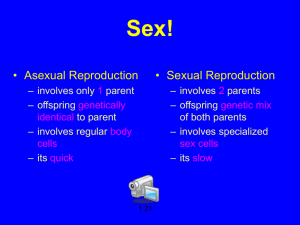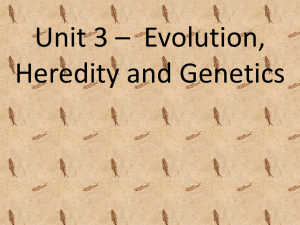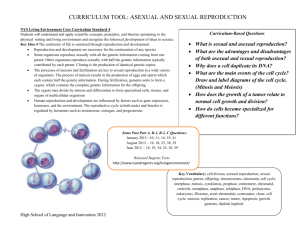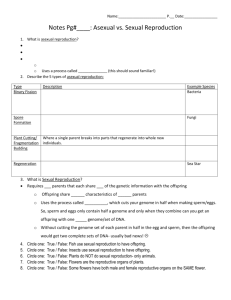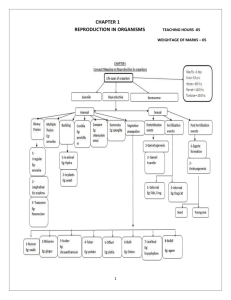Lesson Plan – Asexual and sexual reproduction (4)
advertisement
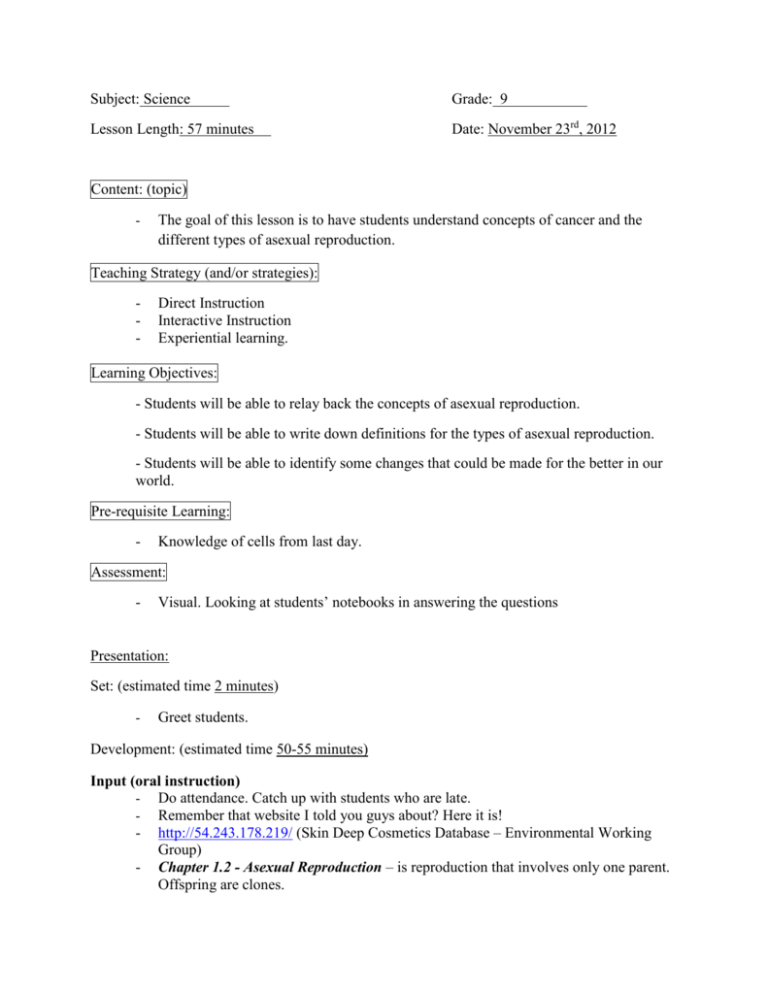
Subject: Science Grade: 9 Lesson Length: 57 minutes Date: November 23rd, 2012 Content: (topic) - The goal of this lesson is to have students understand concepts of cancer and the different types of asexual reproduction. Teaching Strategy (and/or strategies): - Direct Instruction Interactive Instruction Experiential learning. Learning Objectives: - Students will be able to relay back the concepts of asexual reproduction. - Students will be able to write down definitions for the types of asexual reproduction. - Students will be able to identify some changes that could be made for the better in our world. Pre-requisite Learning: - Knowledge of cells from last day. Assessment: - Visual. Looking at students’ notebooks in answering the questions Presentation: Set: (estimated time 2 minutes) - Greet students. Development: (estimated time 50-55 minutes) Input (oral instruction) - Do attendance. Catch up with students who are late. - Remember that website I told you guys about? Here it is! - http://54.243.178.219/ (Skin Deep Cosmetics Database – Environmental Working Group) - Chapter 1.2 - Asexual Reproduction – is reproduction that involves only one parent. Offspring are clones. - - Types of Asexual Reproduction o Binary fission – when single-celled organisms, such as bacteria, amoebas, and some algae, divide into two identical daughter cells to produce two new individuals that are identical to each other and are clones of the parent cell. o Budding – parent produces a small bud or miniaturized clone (i.e. – yeast). Buds eventually detach and become separate individuals. In other animals, they don’t detach and you get a large structure composed of many identical individuals. o (Start Here) Parthenogenesis – is the process by which unfertilized, haploid eggs mature into new organisms. Used by ants, bees, certain species of snakes and lizards. In bees, unfertilized eggs become male drones, whereas fertilized eggs become female workers and queens. o Spores – Haploid cells that can develop into new organisms. Spores are not sex cells but simply haploid reproductive cells. They cannot be fertilized to produce offspring. Protect the DNA of the organism against unfavourable environmental conditions. (e.g. – Fungi, green algae, some moulds, non-flowering plants like ferns.) Black mould is formed by spores and black mould is toxic when inhaled. o Vegetative Reproduction – asexual production of identical offspring, or clones, from the parent plant. No seed is formed. (i.e. – potatoes. On the farm, that’s how we planted our potatoes, was from taking older ones that were growing eyes and those creepy white prongs, cutting them in pieces, and simply putting them in the ground to grow). o Fragmentation – New individuals are formed from a piece of the existing parent organism. Worms, for example, can grow into two identical individuals after being cut in half. Starfish can do it too. Some organisms also have the ability to regrow limbs and parts of their body. Anyone watch “The Amazing Spider-man”? Dr. Conners is fascinated with how lizards were able to regenerate their tails or limbs after they’d been severed so he seeks to try and make this process available to humans. The process turns him into a raging lizard though so the moral of the story is, don’t try to be a lizard. o Grafting – Is a process in which a part of one plant is joined with another plant. The plants heal together and grow as a single plant but end up maintaining their own characteristics. Mainly used for making gardens look pretty or for orchards. o Plant Tissue Cultures – Plant cells placed in a petri dish containing the necessities of growth so that they can grow until they can be transplanted to soil and grown like a normal plant. Kind of similar to the concept of “invitro-fertilization”, which we’ll get into later. This is fascinating because scientists will use an almost similar process when trying to construct genetically modified organisms (ever heard of a grapple?). What will occur is that scientists will attempt to almost force the DNA of two different organisms together in the hopes that they mesh and create something new. They’re almost forcing an asexual organism to be sexual until it can produce the combination of the two organism’s DNA on its own. They quite literally shoot pieces of DNA with a .22 calibre charge that fires a metal particle coated with DNA into plant tissue. Have students do questions 1, 2, 6, and 7. They should use their daily notebooks to do so. Sexual reproduction in plants and animals is the union of two sex cells, also called gametes, to produce a new individual. Gametes – a sex cell. They are haploid. Most animals and flowering plants reproduce sexually. Mix of traits from both parents - - - Meiosis – Have students draw the chart. Parent cell goes through interphase, chromosomes are duplicated. Sexual reproduction in animals. Joining of the two gametes creates a new single cell = zygote. Full set of chromosomes. Divides into two cells starting at cleavage. Zygote = a single cell produced from the joining of two gametes. Cleavage = the process by which a zygote divides into two or more cells to produce an embryo. Embryo = an undeveloped multicellular life form during the earliest stage of its development. The CRITICAL Role of Meiosis in Sexual Reproduction Gametes need to be haploid because otherwise the zygote would inherit twice as many chromosomes as it needs and an incorrect number of chromosomes can cause problems with normal cell function and growth. Each parent contributes 23 chromosomes to make up 46. If there is an extra chromosome, it causes Down Syndrome. Advantages and disadvantages of Sexual reproduction o Mixed traits, better able to combat changes in the environment. o Lots of variation o Gametes must be produced, which requires different amounts of energy o Gametes must meet (in humans for example, there is a prime time to reproduce, women must be ovulating for this to occur. Relatively small time frame to get pregnant. Also, sex doesn’t guarantee pregnancy.) o Large amount of time and energy dedicated to producing (pregnancy) so there’s a limited amount of offspring http://education-portal.com/academy/lesson/asexual-versus-sexual-reproduction.html (Show this video once asexual and sexual reproduction have been covered) Organisms that produce sexually and asexually (i.e. – sponges…makes you think about spongebob squarepants in a whole new way). Closure (2-3 minutes): - Let students know that we’ll be delving into “sexual reproduction” further. Adaptive Dimensions: - Agenda, blocking information. Professional Development Plan: Topic: Asexual and Sexual Reproduction Date: November 23rd, 2012 Name: Stephanie Possberg Observer(s): Mr. Mike Van Betuw Professional Target/Goal/Objective - Addressing questions. Instructions for Observer - If students asked a question, was the teacher able to give a clear and concise answer? - After giving an answer, observe the reaction of the students. Did they seem satisfied with the answer or did they express blatant confusion?




